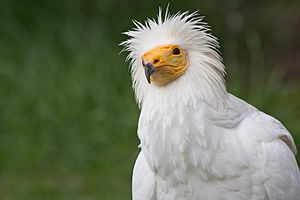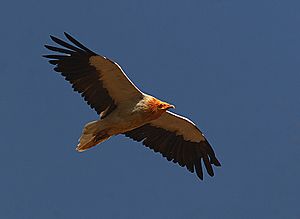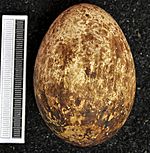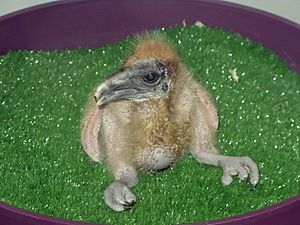Egyptian vulture facts for kids
Quick facts for kids Egyptian vulture |
|
|---|---|
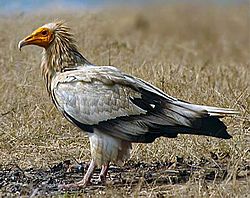 |
|
| Adult in worn or "painted" plumage | |
| Conservation status | |
| Scientific classification | |
| Kingdom: | |
| Class: | |
| Order: | |
| Family: | |
| Genus: |
Neophron
|
| Binomial name | |
| Neophron percnopterus |
|
The Egyptian vulture (Neophron percnopterus) is a medium-sized Old World vulture. You can find these birds from southwestern Europe and northern Africa all the way to southern Asia. It is the only living member of its group, called Neophron. In Southern Asia, people often call this bird the scavenger vulture.
Contents
What Does the Egyptian Vulture Look Like?
Adult Egyptian vultures have mostly white feathers. Their wing tips, used for flying, are black. In the wild, their white feathers often look rusty or brown. This color comes from mud or iron-rich soil. Vultures in zoos, without access to this soil, stay clean and white.
This vulture has a thin, long beak with a hooked tip. Its nose opening is a long, horizontal slit. The feathers on its neck are long and fluffy. Its wings are pointed, and its tail is shaped like a wedge. Adult birds have pink legs, while young birds have grey legs. Their claws are long and straight.
The skin on their face is yellow and has no feathers. You can't tell male and female vultures apart by their feathers. However, breeding males have a brighter orange face than females. Females are usually a bit bigger and heavier than males. Young vultures are dark brown or black with patches of black and white. They get their adult white feathers when they are about five years old.
An adult Egyptian vulture is about 47 to 65 centimeters (18.5 to 25.5 inches) long. Their wingspan is about 2.7 times their body length. This means their wings can spread out very wide! Vultures from Spain weigh about 1.9 kilograms (4.2 pounds). Birds from the Canary Islands, a special type called majorensis, are heavier. They weigh about 2.4 kilograms (5.3 pounds) on average.
Where Do Egyptian Vultures Live and Travel?
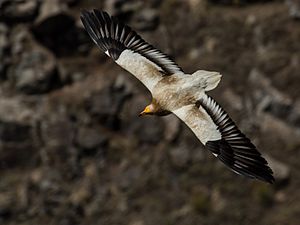
Egyptian vultures live across many parts of the Old World. They breed in southern Europe, northern Africa, and across western and southern Asia. They prefer dry plains and lower hills. In the Himalayas, they can be found up to 2,000 meters (6,560 feet) high in summer.
Many Egyptian vultures in Europe fly south to Africa for the winter. They try to avoid flying long distances over open water. For example, birds from Italy fly through Sicily and into Tunisia. Those from Spain cross into Africa over the Strait of Gibraltar. Young birds that are not yet old enough to breed might stay in Africa for the whole winter.
These migrating birds can fly up to 500 kilometers (310 miles) in a single day. They travel between 3,500 to 5,500 kilometers (2,175 to 3,418 miles) from their summer homes to the southern edge of the Sahara desert.
How Do Egyptian Vultures Behave?
Egyptian vultures are usually seen alone or in pairs. They often soar high in the sky with other birds of prey. They also perch on the ground or on top of buildings. When they walk, they waddle a bit.
They eat a variety of things. This includes animal waste (even human waste), insects found in dung, dead animals (carrion), plants, and sometimes small live animals. When they join other vultures at a dead animal, they usually wait on the side until the bigger vultures leave. Studies show they eat animal waste to get special colors for their bright yellow and orange faces.
Egyptian vultures are mostly quiet. But they make high-pitched sounds or hisses at their nests. When they fight over food, they make screeching noises. Young birds sometimes make a hissing croak when flying. They also hiss or growl if they feel threatened or angry.
These vultures often gather to sleep together in large trees, on buildings, or on cliffs. They choose sleeping spots close to places where they can find food, like dump sites.
How Do Egyptian Vultures Reproduce?
The breeding season for Egyptian vultures is in spring. During this time, male and female pairs soar high together. They might make steep dives as part of their courting dance. These birds are monogamous, meaning they stay with the same partner for more than one breeding season. They often use the same nest sites year after year.
Their nest is a messy platform made of twigs. They line it with soft materials like rags. Nests are usually built on cliff ledges, on buildings, or in the fork of a large tree. Sometimes, they take over old nests built by eagles.
The female usually lays two eggs. Both parents take turns sitting on the eggs to keep them warm. The eggs are reddish-brown with darker spots. The first egg hatches after about 42 days. The second chick might hatch a few days later. If there's a long delay, the second chick might not survive.
Young vultures leave the nest when they are about 90 to 110 days old. Even after leaving the nest, they still depend on their parents for food for at least another month. Once they can find food on their own, they move away from their parents' area. Young birds have been found almost 500 kilometers (310 miles) from their nest!
One-year-old European vultures fly to Africa and stay there for at least a year. They get their full adult feathers when they are four or five years old. Egyptian vultures can live up to 37 years in zoos and at least 21 years in the wild.
Do Egyptian Vultures Use Tools?
Some Egyptian vultures, especially in Africa, are known for using stones as tools. When they find a large egg, like an ostrich egg, they pick up a pebble in their beak. Then, they swing their neck down and throw the pebble at the egg. They keep doing this until the egg cracks open. They prefer using round pebbles. This amazing behavior was first reported in 1877. However, this tool use has only been seen in Africa, not in other places. Scientists believe this behavior is natural, not something they learn from other birds.
What Threats Do Egyptian Vultures Face?
Healthy adult Egyptian vultures don't have many natural enemies. But human activities cause many problems for them. They can get hurt by flying into power lines. Hunting, poisoning, and eating lead from bullets in dead animals also harm them. Pesticides, which are chemicals used to kill pests, can also make them sick.
Young birds in nests can sometimes be caught by golden eagles, eagle owls, and red foxes. If young birds fall from cliffs, they might be eaten by animals like jackals, foxes, and wolves.
Egyptian vulture numbers have gone down in most places where they live. In Europe and the Middle East, their numbers were cut in half between 1980 and 2001. In India, their population has dropped very quickly, by 35% each year since 1999. One reason for this decline might be a medicine called Diclofenac, which is harmful to vultures.
In Italy, the number of breeding pairs dropped from 30 in 1970 to only 9 in the 1990s. Most of these problems were caused by human actions. In Spain, which has about half of Europe's Egyptian vultures, problems include lead poisoning, pesticides, and getting shocked by power lines. Wind farms can also be a danger.
Sometimes, there isn't enough dead animal meat for them to eat. This can happen when rules change about how to get rid of dead animals. In Armenia, some vultures are hunted or caught to be sold as pets.
The Egyptian vultures on the Canary Islands have been separate from other groups for a long time. Their population dropped by 30% between 1987 and 1998. To help these birds, people have tried creating "vulture restaurants." These are places where safe, clean dead animals are left for the vultures to eat.
Egyptian Vultures in Culture
Ancient Egypt
In Ancient Egypt, the vulture hieroglyph was a special symbol. The bird was considered sacred to the goddess Isis. Because the vulture was a symbol of royalty in Egyptian culture, and protected by laws, these birds were common in Egyptian cities. This is why they were sometimes called "pharaoh's chicken."
India
There was a famous temple in southern India at Thirukazhukundram. For centuries, a pair of birds supposedly visited this temple every day. Priests would feed these birds special offerings made of rice, wheat, and sugar. People believed that if the birds didn't show up, it meant there were "sinners" among the people watching.
Spain
Because Egyptian vultures sometimes eat animal waste, they have Spanish names like "churretero" and "moñiguero." These names mean "dung-eater."
Images for kids
-
An Egyptian vulture flying in India.
See also
 In Spanish: Alimoche común para niños
In Spanish: Alimoche común para niños



